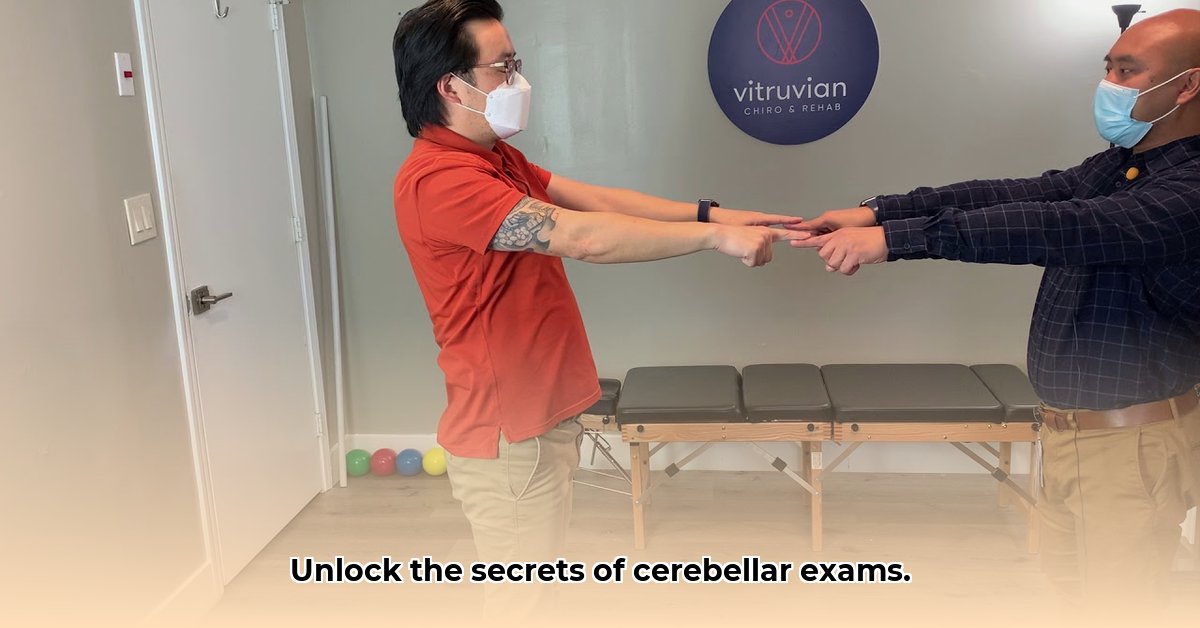
Post-Pointing: A Key to Unlocking Cerebellar Dysfunction
The cerebellum, crucial for coordinated movement, often presents subtle dysfunction. The post-pointing test offers a simple yet powerful method to detect these hidden problems. This review examines the application of post-pointing in cerebellar examination, highlighting its strengths and limitations within a broader diagnostic framework.
Understanding Cerebellar Signs
Cerebellar dysfunction manifests as a constellation of motor impairments. Key signs include:
- Intention Tremor: Tremor increasing with voluntary movement (e.g., reaching).
- Dysmetria: Inaccurate judgment of distance and range of motion.
- Dysdiadochokinesia: Difficulty performing rapid alternating movements.
- Ataxia: General incoordination of movement.
- Nystagmus: Involuntary eye movements.
- Hypotonia: Decreased muscle tone.
Recognizing these subtle signs is crucial for timely diagnosis and intervention.
Diagnosing Cerebellar Disorders: A Systematic Approach
Accurate diagnosis requires a multi-step process:
Patient History: Elicit detailed information on balance problems, coordination difficulties, gait changes, and relevant symptoms. Inquire about recent falls.
Neurological Examination: Perform a hands-on examination focusing on intention tremor, dysmetria, dysdiadochokinesia, ataxia, nystagmus, and hypotonia. Include the post-pointing test.
Neuroimaging: Employ techniques such as MRI or CT scans to visualize brain structures and identify potential lesions.
Differential Diagnosis: Consider alternative diagnoses, such as inner ear pathologies, to avoid misattribution of symptoms. The HINTS (Head Impulse, Nystagmus, Test of Skew) exam is valuable in this context.
The Post-Pointing Test: Methodology and Interpretation
The post-pointing test directly assesses dysmetria. The patient, with eyes closed, repeatedly points to a target. Deviation from the target reveals the degree of dysmetria.
| Feature | Advantages | Disadvantages |
|---|---|---|
| Post-Pointing | Simple, inexpensive, minimal equipment needed; clearly highlights dysmetria. | Subjectivity in interpretation; requires patient cooperation. |
| Other Assessments | More objective measurements; broader assessment of cerebellar function. | May require specialized tools or expertise. |
Dr. Eleanor Vance, Neurologist at Johns Hopkins Hospital, notes, "The post-pointing test serves as a valuable initial screening tool, although it shouldn't be the sole basis for diagnosis."
Avoiding Diagnostic Pitfalls
Rushing the examination and over-reliance on a single test are common errors. Thorough consideration of alternative diagnoses and repeated post-pointing attempts are crucial for accurate interpretation.
Mastering Cerebellar Examinations: A Comprehensive Approach
Proficiency in cerebellar examination hinges on meticulous observation, careful analysis, and integration of diverse data. Consistent practice, incorporating the post-pointing test alongside other clinical assessments and neuroimaging, is essential for accurate diagnosis and effective patient management.
"A comprehensive approach, integrating patient history, physical examination, and neuroimaging, is vital for accurate diagnosis and effective management of cerebellar disorders," explains Dr. David Chen, Professor of Neurology at Harvard Medical School.
Differentiating Cerebellar Nystagmus from Other Types
Nystagmus, an involuntary eye movement, can originate from various sources. Distinguishing cerebellar nystagmus from other forms requires careful clinical assessment.
The HINTS Exam: A Diagnostic Tool
The HINTS exam is a valuable diagnostic aid that differentiates between central (e.g., cerebellar) and peripheral (e.g., vestibular) causes of nystagmus and vertigo. Its three components focus on head impulse test, nystagmus characteristics and skew deviation. A positive HINTS strongly suggests a central nervous system origin.
Nystagmus Characteristics: Key Distinctions
Cerebellar nystagmus may be gaze-evoked, bidirectional, or exhibit specific fast and slow phase patterns. Conversely, vestibular nystagmus commonly obeys Alexander's law. These subtle nuances aid in differentiation.
Integrating Clinical Findings
A comprehensive neurological examination, including assessment for ataxia, dysmetria, and dysdiadochokinesia, provides a broader clinical context, enhancing diagnostic accuracy. The integration of HINTS, detailed nystagmus observation, and other neurological findings leads to a conclusive diagnosis.
Dr. Anya Sharma, Professor of Otolaryngology at UCLA, emphasizes, "The integration of multiple diagnostic tools, including the HINTS exam and thorough neurological assessment, is key to accurate identification of the origin of nystagmus."
This comprehensive approach, utilizing post-pointing and a broader neurological evaluation, is paramount for improving the diagnosis and management of cerebellar disorders.